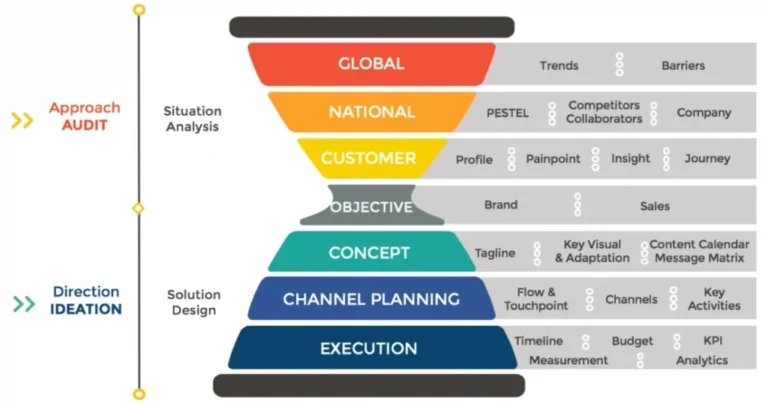
I wrote the first article of Sand Clock Series about communications to share my understanding on how consistent models can help to fast-track the planning and support creativity in the whole process of project management of an agency. However, I believe that if one can truly comprehend the model, it can be generally applied in many kinds of strategic thinking and planning. For this reason, I also want to share my experience of applying Sand Clock Strategy Model in the brand planning process at my company, Wisdom Agency.
Rejuvenated in 2017, Wisdom is a boutique agency that focuses on strategy consultancy for middle-sized companies; the use of Sand Clock Strategy as an internal planning is therefore optimally designed to serve these niche clients. For this reason, it may not be suited for large-sized companies or other kinds of planning like brand, marketing, communications and content in global agencies. For junior planners, this model is like the London system or Colle system in chess that can be used for all kinds of games. For senior planners, this model can be used as a simple tool to cross-check the planning work or efficient way to do things fast.
The Sand Clock Strategy Series employ the similar principles for both strategic thinking and planning. However, there are minor variations depending on the types of planning such as brand or communications. Indeed, there are basic differences between brand and communications.
Duration
- Communications: three to six months on average. Some companies have annual plans for communications with consistent concepts and messages, but most of middle-sized companies do not.
- Branding: several years. After a company has passed its infancy stage, it is strongly recommended that the entity keeps its brand identity consistent. In fact, changing branding strategy so often will reduce the brand equity and the ability to recall the brand of customers.
- In a nutshell, communications can be likened to clothes outfit style that a person may change after a period, whereas branding is more like characteristics to define a person which should only be changed gradually over a long period of time as the brand matures.
Scale
- Communications is usually the work of one department, the marketing one.
- Branding usually involved many departments of a company to fulfil the complete brand experience. The brand experience and all the brand touch-points of customers can vary from communications to product, customer service and even finance. Brand in other words can be defined as an entity bigger than business itself as one good brand can be used for many businesses. This example can easily be found in large corporations with monolithic brand architecture such as Virgin Group Ltd. in UK or Vietnam.
Principles
Brand planning model as a part of the Sand Clock Strategy Series also employs three similar principles of strategy:
- Principle #1: strategy comprises three steps which are thinking – planning and doing.
- Principle #2: good strategy has three attributes: thorough diagnosis, guiding policies, and coherent actions.
- Principle #3: strategic planning comprises two main parts: Situation Analysis (SA) and Solution Design (SD)
Part 1 of this series can provide a deeper understanding of these principles for readers who have not read it by following the link:
https://www.linkedin.com/pulse/sand-clock-strategy-model-communications-planners-minh-h-nguyen/
For Part 2, there are four prerequisites taken from the perspective of a middle-sized company that must be agreed on.
What is branding?
In essence, branding is to establish brand as a person with defined character. A brand in the market can be likened to a guy in bar who is looking for a way to attract people around him, especially the girls. In this situation, all the methods that he applies to become noticeable and outstanding from the crowd are parts of the so-called branding which is to charm people by his good look, his interesting conversation and finally make them like the way he is.
Interestingly, the fact that people process information to decide whether to love or hate a matter is quite the same if it is going to be a person or a commercial brand.
Why does one need to do branding?
Simply speaking, the guy cannot attract many people if he is simply in the bar but does not talk or do anything interesting. Like a brand in the market, an excellent presence in everywhere does not guarantee that people will like the brand unless it can do something meaningful and interesting. To attractive people, the guy needs to talk, and he must tell an interesting story about himself. That is also a part of doing branding which is telling an interesting story about the brand and engaging with customers. In short, if a brand wants to sell more, it can try to engage customers in an interesting conversation by doing the work we call branding.
When to do branding?
For a middle-sized company, branding may not be a priority as there are many more matters and aspects of the business to be taken care of. In fact, it is recommended that companies should not start branding when their products and services are not ready because it will create bad reputation for all the under-delivered promises from brands. Therefore, the right time to start branding is crucial.
On the one hand, some says that branding starts when the company has a logo and begins to display it. On the other hand, some says that a company needs so many more than just a logo to do branding. The second opinion should be considered the correct one. In fact, having a brand and doing brand are very different like knowing how to walk and knowing how to run, the later one requires more skills to matter.
Of course, all companies have logos for brands; the question here is when a company should invest on branding? For a middle-sized company, I think branding is the prerequisite to grow large. As a matter of fact, no businesses have ever gone far without a good branding plan. Another sign that companies can consider is the concept of revenue ceiling. When a business has reached a certain level of size and stayed there for quite a while, it might be a sign that it cannot grow further without a concrete foundation of branding; therefore, it is time to reinforce the base of branding to heighten the up the skyscraper.
What are needed to do branding?
The first element needed to do branding is intrinsic value. In fact, all branding will be a false statement without intrinsic value of the product.
The second element is budget and time. These SC series define branding to be more of an investment than a cost. In fact, a good brand can have an everlasting effect even after the business is closed or being applied on other business models. However, since it does have not immediate effect, it demands much effort of both money and time from the time being. Take an example like the split of business in which one can only take the possession of either a brand or the infrastructure. What is your best choice here?
In conclusion, branding can only be effective if the business owners set the right expectation for it. It is not likely to be the immediate effect right after launching but rather an accumulation of right actions over a long period of time.
What this model is all about?
First, this is branding from the perspective of a brand agency, not client’s internal brand team. Second, this series only offer a shortcut to strategy of brand and more for marketers working with middle-sized businesses. There are several models to be used for branding; all of them with different kinds of approaches contain somewhat the same elements.
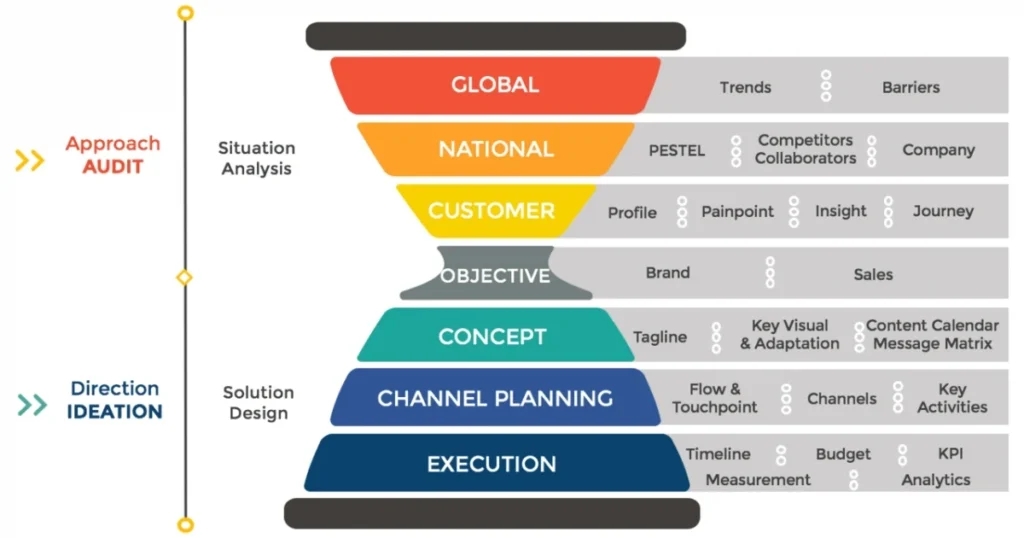
Without further due, here is the 6-step process for brand building by the Sand Clock Strategy’s way
Part I: Situation Analysis
Like the Situation Analysis (SA) of communications, all good planning starts with right understanding of the situation by the outside-in approach. However, as we shift the focus from communications to branding there are changes of the same Situation Analysis (SA).
1. Global (Global Trends | Local Adaptation)
Global trends:
Unlike communications, the trendy factors do not affect that much in branding. One recommended way is to look for similar brands around the world to study branding and activities. For example, furniture companies in Vietnam can learn from IKEA on how they choose their brand value proposition which is about shopping experience, wide range of well-designed functional products at low price. If there are many similarities between people in Sweden and Vietnam, a local furniture company in Vietnam can adapt the similar value proposition.
In short, whatever the industry is, one should always look for global similar business model to learn and adopt some of the brand proposition or attributes that are suitable for local market.
Local adaptation:
The second matter that one should take care of is about the suitability of local ideas for the brand, even global brands sometimes change their positionings because of the local perception. There are 6 elements in the PESTEL model to consider for local adaptation.

Take food made from insects as an example, as it is considered nutritional and delicious in some parts of the world like Asia, Westerners however rarely consider insects to be part of their daily nutrition treats. Therefore, an insect food brand that positions as “nutritious and delicious” in Asia’s markets will have to change their positioning if they want to penetrate the Western markets. Can you get the positioning that Westerners like? The answer is “environmentally friendly”. Indeed, Westerners are more aware and concerned about the environment problems than Easterners. Thus, they are willing to sacrifice a little bit of personal satisfaction for the sake of the environment.
For reference, check out Bug Burger to see how they convince the world by their philosophy:
The Eating insects startups: Here is the list of Entopreneurs around the world!
2. National (Context | Competitor | Collaborator |Company)
Context:
After looking around in the world, it’s better to look back on the current market. Each country has a different opinion toward brand and loyalty driven by it. After the PESTEL analysis is done, further analysis on brand and customer relationship should be conduct. For Vietnam’s market, I personally believe that:
B2B wide, not many companies in Vietnam are willing to invest much for branding. Some still perceive it as a luxury of premium brands only so when they operate in middle-end or low-end segments, they do not really care. In general, a company must invest more into branding and communicate a meaningful message to its customers no matter what segments it is in.
B2C wide, Vietnamese has lower level of loyalty. But I personally think this is a chance because there are not many established brands in the market. Thus, those progressive brands with right mind-set will have a chance to possess the customer’s share of mind that none has over occupied.
Competitor:
The Five-Forces Model works well in most cases of analysis, where not only direct competition is analysed but also indirect competition and threat of new entrants together with bargaining power of both suppliers and customers.
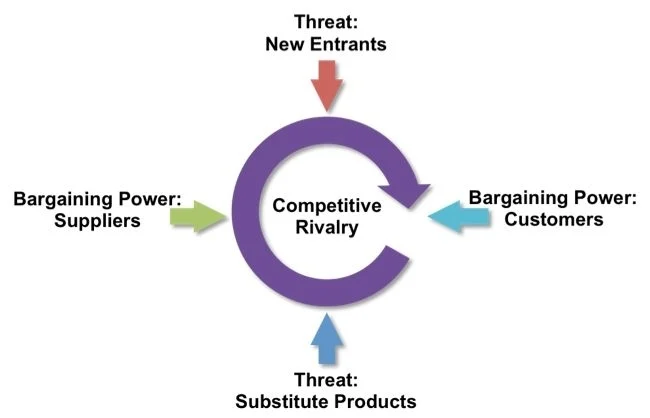
Take shoes for example, Nike, Adidas vs. Biti’s Hunter. Some may say that Biti’s Hunter is not a direct competitor against Nike and Adidas, the fact is it still takes a huge chunk of market share from these two giants. Below is a partly analysis of Biti’s Hunter’s marketing strategy:

“Ambitions to gain 30% value share of sports footwear market value from the year 5: 2.742.000.000.000 VNDwith category growth rate: 7.7 – 8% for 2016- 2020 to 3.860.000.000 VND
Sports footwear subcategory: high performance outdoor/casual sports, and sports – inspired: 31,5%market scattering with no dominant player: though Nike, Adidas top the market shares but with just 2% per brand.
Common share is 0,5% – 1,5%. There is a price gap of 500k – 800k VND segment for high quality products.
Distribution: online less than 5%, 66% for small multi-product stores, 10% for MT/supermarkets, less than 20% for branded stores.
Sports-inspired footwear is driven by: pricing, comfort, design & imagery.
Biti’s Hunter will compete mainly in SPORT-INSPIRED FOOTWEAR SUBCATEGORY, NOT HIGH PERFORMANCE where Nike, and Adidas have more powerful competency & credentials, focusing on comfort & design with value for money pricing.”
It is stated clearly in the strategy that Biti’s Hunter does not complete directly with Nike and Adidas, but the truth is people no longer need to pay that high for a pair of running shoes because they can opt for Biti’s Hunter instead.
Collaborator:
With the same case-studies of Biti’s Hunter, but here it is not about celebrity endorsement only. Collaboration by a broader definition is more about finding the right partner in the industry to work with and benefit both sides. Moreover, it can also mean to build an ecosystem of brands to create synergy. It means when one is looking for a way to co-brand, it should not be just about the positioning or brand characteristics. Look for a way to enhance the experience with customers. For example, Apple and Nike are two great samples of co-branding when they Apple’s integrated chips into Nike’s shoes to track runners’ progress of exercise and then advised them how to improve their performance on a daily basis
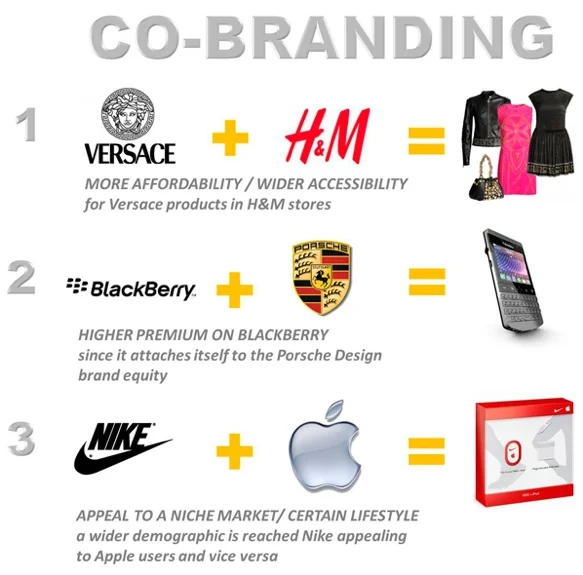
Company:
Before doing any kind of branding, it’s good to look back internally to know the company’s resource and what they are the best for. In practice, this one is usually done by a thorough research, either primary or secondary. Research is to identify the pros and cons, strengths and weaknesses, directions and business strategy so that the findings can be adapted into branding. Brand is not the focus of short-term plan. To have a good one, company should focus their effort to build for long term by having ample resource. I encountered many situations in my career that clients ask for branding to overcome the current difficulties which is just wrong. Brand plan cannot solve the problems ahead.
Taking internal analysis is also a chance for the company’s board to understand about the culture of the business, the parity and difference of their products which act as the raw materials for brand building
3. Customer (Profile | Interest| Journey)
Profile:
Profile matching between brand and people. People choose brands because they can relate to them as part of their personalities. Take watches as an example, a tech savvy is more like to choose Apple Watch, while a fashionable personality tends to choose Daniel Wellington and a business professional probably opts for classical brands such as Rolex or Omega. Thus, choose a niche group of customers and invest on them wisely. Readers can refer to the case study of Coke and Pepsi that was mentioned in Part 1 of this series.
Note that no company has an unlimited resource. Therefore, it would be wise to target a small group of customers rather than to go for all available profiles. This is one of the three key principles of the Blue Ocean Strategy (Mauborgne et al, 2014).
Interest:
This is the most effective customer segmentation until now. It was proven and mentioned in a recent issue of CIM, the Catalyst, about this matter. For example, brands are more likely to target men if they can work with sports or car magazines. Similarly, brands are more likely to target women if they work with cuisine or fashion magazines. Unlike segmentation that rely on demographic factors such as age and income; this method has been proven to be the most effective.
Journey:
Some may ask why branding still need a customer journey. Modern branding theory has confirmed that branding is no longer just about the effect of communications. As the matter of fact, branding is more about the product now. Hence, brand managers should take a holistic view of branding and work closely with product and other departments.
Banking as a new and very dynamic business sector is applying this principle to rejuvenate their old brands and provide complete experience to customers. Here is an example of a brand touch-point model of a local bank in Vietnam. All the effort of brand building they put in was to lift experience of their customers from pain points to positive ones.
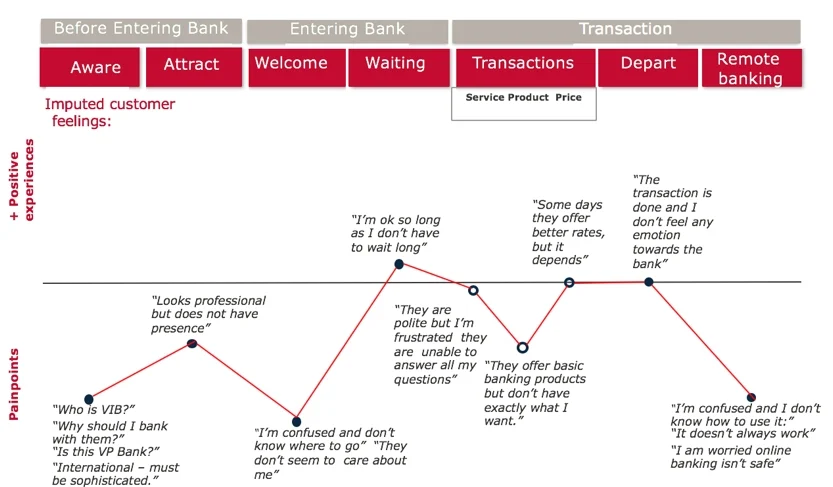
Part 2: Solution Design
This part comprises of there sections. Like Sand Clock Strategy for communications, the work in Solution Design (SD) part is also to identify the core of brand and then spread it now by the effective use of channels and activities.
4. Brand Platform (Philosophy | Proposition| Brand Attributes | Brand Identity & Language)
Philosophy:
To make it clear there are two types of branding which are corporate branding and product branding. In the former version, business philosophy is more important to be identified and put down on paper. Some may argue that with a product branding plan there is no need to do it but I find out that it is still necessary somehow because in the end all product brands are derivatives of the corporate brands. Further, corporate brands have the power to influence employees, the brand managers, who in turn manage the product brands. There are three components of business philosophy which are Vision, Mission and Core Values.
- Vision: what the company aspire to achieve in the long run
- Mission: what the company is doing on daily basis
- Core Values: the internal values that company’s leaders and employees follow. Following this principle, Corporate Core Values is mostly used for internal brand marketing communications effort.
Positioning:
A core component of a brand development is the brand proposition or practically called brand statement. A brand proposition should clearly identify the benefits that a consumer derives out of the brand. Good brand proposition however should include the Unique Selling Proposition (USP) that no other brand can provide. The unique selling proposition can be used as a brand positioning for communications. One method to identify it is illustrated in the model below:
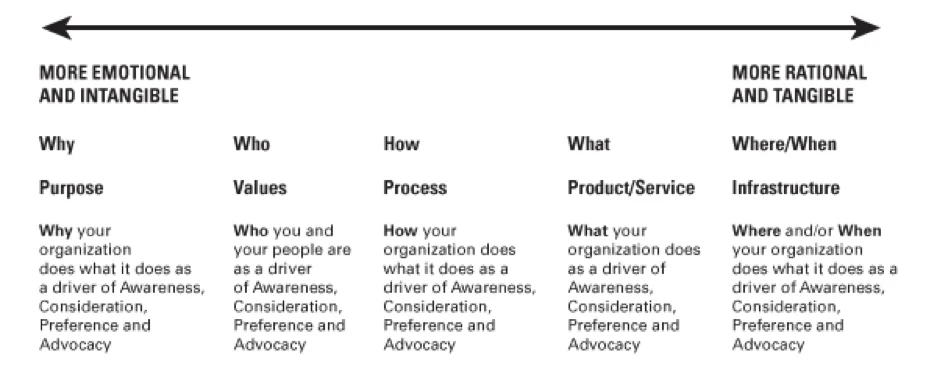
- These five categories can be understood as
- Where: focus on scale such as being the first or the biggest in the market
- What: focus on the product with meaningful benefits both functional and emotional
- How: focus on the quality of service provides
- Who: focus on the values and experience that the company provide
- Why: focus on the cause or reason why the company exists such as helping the community or prevent a social problem
Brand Attributes:
Next, like a person, a brand needs to define its characteristics. Having three up to six attributes is optimal. Having too few attributes, it is hard to the customers to identify the brand; having too many attributes on the other hand costs more money from the company to build brand, not to mention it could be also confusing to customers. Still, having all customer feel the same way about the brand is impossible, but if brands do it in the right way most of the customers can somewhat understand the attributes of their favourite brands.
Take Apple as an example, I always ask all participants in the meeting to tell what they think about the personalities of Apple. It varies from time to time but some of keywords always recur such as:
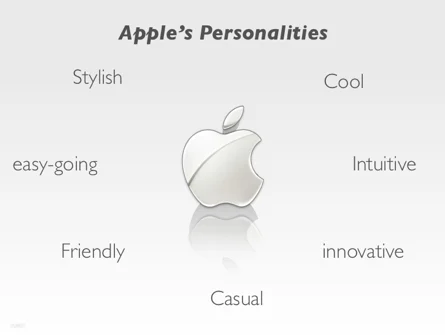
So far, no brand managers from Apple have confirmed exactly what their brand attributes are but the audience surely can distinguish a part of it. Why? Because the internal brand planning of Apple was so much consistent to deliver such brand experience to the mass.Another example is from my experience as I build brand for a furniture company. After a tough round of research including both internal and external ones, all agreed that “durable” was one of the strong attributes that the company needed to build. Interestingly, it originated from the fact that the company had had a long history of 30 years in business. To live up to that expectation, the first thing the brand team decided to do was to improve the durability of all products before launching any brand campaigns.
Brand Identity:
Next, when the brand manager already has his brand attributes defined, it’s time to translate them into practice, and the first part of it is to have a consistent brand identity. Like a person, it is the way one looks.
For brand identity, the first thing the company needs is a logo, but more than that there are several basic elements need to define such as symbol, colour palette, imagery and style, graphic design element, typography. Only then, the brand guideline is completed. In short, brand identity consistency is important and brand managers must ensure that their brands are consistent across all channels and touch points.
Another extended part of the brand identity guideline is adaptations which is samples and templates of common materials such as digital banner or standees.
Brand Language:
For a brand it needs to define its tone of voice like how it communicates to customers. Like a person, it is the way one talk. For example, it could either sound like a professional or a friend, or it could be like a housewife or a modern working female officer. Being gentle or direct? Using story telling or reporting styles? The questions must be answered before any content development.
Brand volume control is another concept. Image that brand is like person named Nick. Nick is a very lively and young boy. He is most likely to express his characteristics at home which is “young, lively and fun”. One day, he has to go to the school. The school’s environment is different, so Nick has to adjust his personality a little bit. Instead of young lively boy, he turns to be a little conservative and more disciplined. Let’s say he is 80% himself and 20% of the environment that he is in. A brand can communicate like the way it is on its owned channels like website, but it also has to adjust its voice when it delivers content on social platforms depending on what kind of platforms it is in. Facebook is long, Twitter is short, Instagram is about images, and tumbler is more about blogging. Different kinds of platforms require different kinds of brand approaches that forces brands to adjust their voices. This kind of concept is called Brand Volume Control.
5. Activity Planning (Milestone | Strategic Framework | Key Activity)
Milestone:
The same concept applies for both communications and branding is the journey from stranger to lover. For brand, it is the journey from brand awareness to brand loyalty or advocacy. However, different stages of brand evolvement require different kinds of tactics. For awareness, brands for example have to run more display ads. For preference, brands have to engage more in BTL activities to educate customers about the functional benefits. For brand love, brands have to promote or associate their images with meaningful social causes such as young generation’s education or environmental issues.
By different kinds of categorisation, there may be more than just my basic three brand objectives including awareness, preference and love. If one wants to dig deep into this matter, the Keller’s Brand Equity Model is highly recommended for further study.
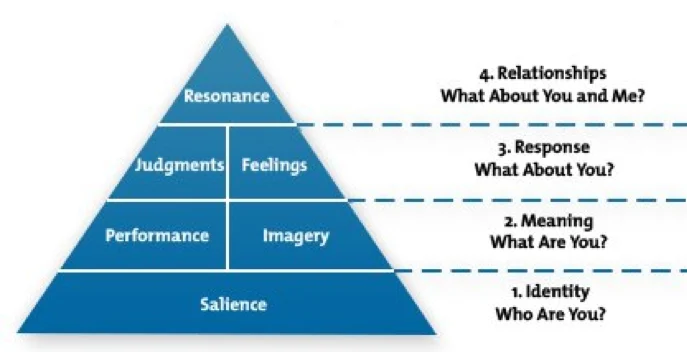
However, whatever brand objectives that are chosen should be seriously considered as great milestones for brand growth and invested considerably over the years to achieve. The haste to literally grow the brand too fast usually result in the waste of budget.
Strategic Framework:
After brand objectives for each periods are identified, channel for activities are built in to form the strategic framework. For branding, channel selection is harder than communications because the choices for branding are more diverse. It is not much about communications such as ATL or BTL; it could be about product or the salesperson as a representative of brand. Doing channel review and planning allows brand managers to have an overview of all brand touch points that are needed to be managed, not just the communications touch points only. Whatever kinds of strategic framework that are chosen, make sure all activities follow and support one single objective for each stage of brand growth.
Key Activity:
Marketing and branding is like writing a song, and a song cannot be beautiful without treble and bass or like the peaks and troughs of marketing and brand activities. For brands to maintain a good relationship with customers they have to define a certain frequency and interval of brand engagement. Too often, customers get bored. Too long waiting, they forget.
One common practice for key activity planning is to plan by quarters. For example, a brand could have mega campaign each two quarters and minor marketing activities along the year. Running 4 major campaigns every year may cost a lot of money without much increase of effectiveness.
6. Execution (Timeline | Budget | KPI | Measurement | Analytics)
Timeline:
Plan is nothing without action; hence it is necessary to have a defined timeline for all planned action and follow through with it. Without deadlines people are not likely to do anything upon the assigned tasks. Strategy comprises three parts, thinking; planning; doing, and I believe the doing is accounted for 80% of the success.
Budget:
Everybody knows that budget is important, but for branding budget is even more important because the nature of branding is like investment for long term and there is nearly no way to invest in long term if the company does not have enough budget to overcome the short-term challenges. Moreover, brands thrive on the philosophy and attributes of the products which also take a very long time to prove, unlike communications that can partially rely on creative idea or technology in case of the lack of good budget.
There are two methods for budget allocation which is per phase and per channel. The former method is more of the guiding principle for brand investment in parallel with brand evolvement stage. The latter method is more on the tactical level that really get the brand rolled out.
KPI:
What one pays is what one gets. However, it is hard to evaluate the effectiveness of a brand strategy simply based on KPIs. In practice, KPIs for brand are usually measured by the scope of work and the seniority of the personnel involved in the project. For a brand plan which is built for 2-or-5-year time frame, how to measure the effectiveness on customers’ perception when the plan in rolled out is more important than the scope in the contract. This fact renders the difficulty of brand consulting partner selection on the experience and intuition of the marketing managers and CEOs.
Measurement & Analytics:
Like communications planning, the whole point of measurement and analytics is to identify the strategic gaps and fix them. As the matter of fact, no plans ever roll out unchanged. Usually the nature of a good strategy depends on how fast the strategy changes itself to adapt to the reality of the execution. Hence, rigorous measurement and analytics are the key role in bridging the gaps between planning and reality. A good measurement and analytics mechanism must include accurate data, continuous tracking, deep analysis and relevant actions of change proposed.
For branding, Brand Health Check (BHC) is the common method of measurement used by many brands in Vietnam. It was originally the tool for FMCG brands but now is used diversely by brands in many sectors such as real estates. Continuous tracking is recommended instead of dipstick tracking which is one-off because it provides a holistic view of the brand growth progress. Analytics and proposed actions of change on the other hand depend on the quality of the agency chosen.
To make the subject comprehensible and practical, I enclose here some of the plan that we – Wisdom Agency – have made for pitching but clients did not buy. I provide the plans only in parts to comply with the company’s confidentiality policies.
Link 1: https://www.slideshare.net/MinhHaiNguyen3/ncb-branding-and-communications-planning
Link 2: https://www.slideshare.net/MinhHaiNguyen3/lancaster-lincohns-brand-communications-strategy
Reference:
- AMPLIMARK, (2018), Brand Proposition and Brand Statement, Online, Accessed on Oct 10th 2018, Available online at: https://www.amplimark.com/brand-proposition/
- Chan Kim, W. & Mauborgne, R. (2015), Blue Ocean Strategy, Harvard Business School Publishing Corporation, USA
- CIM (2017), Chartered Marketer Test, Berkshire, UK
- Kaewjieranai, N. (2011), Apple’s Personalities Stylish Cooleasy-going Intuitive, Online, Accessed on Oct 10th 2018, Available online at: https://www.slideshare.net/tim3flies/apples-brand-personality/5-Apples_Personalities_Stylish_Cooleasygoing_Intuitive
- Keohane, K. (2018), 5 Brand Positioning Model, Online, Accessed on Oct 1st 2018, Available online at: https://www.brandingstrategyinsider.com/2016/09/5-brand-positioning-models.html#.W8h022j7SUk
- MindTools, (2018), Keller’s Brand Equity Model, Online, Accessed on Sep 25th 2018, Available online at: https://www.mindtools.com/pages/article/keller-brand-equity-model.htm
- Minh, N. H. (2018), “Sand Clock Strategy – Communications Planning Model,” Online, Accessed on Aug 14th 2018, Available at: https://www.linkedin.com/pulse/sand-clock-strategy-model-communications-planners-minh-h-nguyen/
- Porter, M., (2008), “Competitive Strategy: Techniques for Analysing Industries and Competitors”, The Free Press, New York
- Richard Rumelt (2011), “Good Strategy, Bad Strategy – The Difference and Why It Matter,” Crown Publishing, US